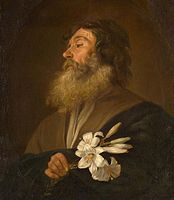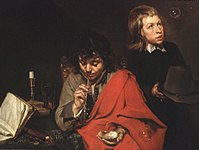| Michaelina Wautier | |
|---|---|
 Self-portrait, 1649 Self-portrait, 1649 | |
| Born | 1604 Mons, County of Hainaut, Habsburg Netherlands |
| Died | 1689(1689-00-00) (aged 84–85) Brussels, Duchy of Brabant, Habsburg Netherlands |
| Nationality | Flemish |
| Notable work | The Triumph of Bacchus (1650) |
| Movement | Baroque painting |
| Family | Charles Wautier (brother) |
Michaelina Wautier, also Woutiers (1604–1689), was a painter from the Southern Netherlands. Only since the turn of the 21st century has her work been recognized as that of the outstanding female artist of Flemish Baroque painting, her works having been previously attributed to male artists, especially her brother Charles.
Wautier was noted for the variety of subjects and genres that she worked in. This was unusual for female artists of the time who were more often restricted to smaller paintings, generally portraits or still-lifes.
Biography

Born in 1604 in Mons, Belgium, in the French-speaking region of Wallonia, Michaelina Wautier was the only daughter in a family of nine children. Scholars assume that she came from a wealthy family, as her work shows an in-depth knowledge of classical mythology and symbolism. She appears to have begun her artistic career later in life, around the age of 39, however, her talent evidently did not long go unnoticed. Possibly as a result of her brother Charles’ contacts in the army as he had previously been an officer she was commissioned to do a portrait of the aristocratic general Andrea Cantelmo. That painting has since disappeared, but its existence is known through an engraving of it done by Paulus Pontius. Charles was also a painter, and the two moved to Brussels in 1645, where they both remained unmarried and shared a studio.
After arriving in Brussels, they lived in a mansion near the Chapel Church in the Marolles district. Both Michaelina and Charles seemed to have been active in business, particularly in real estate. Both also were almost certainly well-trained in art, but it is not known where or with whom. Little else is known about Wautier's life, and much of her biographical information is based on scholarly conjecture and analysis of her available works.
Works
Main article: List of paintings by Michaelina WautierMichaelina Wautier painted in small formats as well as more ambitious canvases with as main subjects history, religion and mythology. At the time, large format paintings were still considered a preserve of male painters. Wautier multiplied representations of genre scenes, historical paintings, as well as more detailed representations of flower garlands. Her works also include a series of portraits. She was distinguished from other painters by the diversity of her subjects and formats.
Her first self-portrait, painted in 1649, was long mistakenly associated with the Italian painter Artemisia Gentileschi. It remains one of Wautier's most famous paintings. The painting is included in the 1905 book Women Painters of the World. It was not until 1672 that the painter Elisabeth-Sophie Chéron produced what is considered the first female self-portrait in France.

The painting named The Triumph of Bacchus (1650, Kunsthistorisches Museum in Vienna) is often cited as one of the most representative of her works. She was familiar with masculine anatomy and painted it without shame, becoming one of the first female painters to expose a naked man. The artist depicted herself in the colourful crowd; she is the only character to look at the viewer. Further, the large scale of the painting was notable for a female artist of the time for, as McCouat says, "women were patronisingly regarded as not being capable of such large-scale complex works".
Unlike many other women painters of this period, Wautier received recognition while alive. In particular, she sold four paintings to Archduke Leopold Wilhelm of Austria for his painting gallery. The paintings are mentioned in the inventory of the collection drawn up in 1659. However, her work fell into oblivion after her death. Some art historians link this absence to the attribution of her paintings to Thomas Willeboirts Bosschaert, Jacob van Oost or her brother Charles Wautier. Additionally, art scholar Katlijne van der Stighelen notes that there was a long period between her last painting (believed to be in 1659) and her death in 1689, at the advanced age of 85, during which she was not producing paintings or staying in the public eye. Further, unlike some of her female contemporaries, including the Italians Gentileschi and Elisabetta Sirani, her self-portrait was never issued as a print to perpetuate her memory. In fact, eventually that self-portrait itself was later attributed to Gentileschi.
Legacy
After Wautier's death in 1689, her legacy was quickly lost due to the various reasons: mis-attribution, confusion with other noted female artists of the period, and inability to differentiate her work from that of her brother Charles. Two centuries later, starting in the 1850s, recognition of her work began to pick up again. However, any mention of her was usually limited to a characterization of her as a "skilled portraitist" with few attributed works.
Her reputation enjoyed a revival starting in the 1960s with the sudden appearance of her floral still life Garland with a Butterfly in an exhibition, which later disappeared in 1985, along with her official recognition as the rightful creator of The Triumph of Bacchus in 1967. The art historian, intellectual, and feminist Germaine Greer gave Wautier coverage in her book The Obstacle Race: The Fortunes of Women Painters and Their Work (1979). Commenting on her work Portrait of a Commander in the Spanish Army, Greer said that Wautier displayed "swiftness and accuracy" indicating extensive professional practice. More re-attributions and recognitions of her works and exhibitions that included her paintings made her legacy to more of the art-going public. The greater interest in her work culminated in her first dedicated exhibition in 2018.
Paintings
-
 Portrait of Martino Martini (1654), Private collection
Portrait of Martino Martini (1654), Private collection
-
 St Joseph holding white lilies (1650), Kunsthistorisches Museum, Vienna.
St Joseph holding white lilies (1650), Kunsthistorisches Museum, Vienna.
-
 Two Boys Blowing Bubbles (between 1640 and 1650), Seattle Art Museum, Seattle.
Two Boys Blowing Bubbles (between 1640 and 1650), Seattle Art Museum, Seattle.
-
 Elk zijn meug, The Phoebus Foundation
Elk zijn meug, The Phoebus Foundation
-
 A youth smoking a pipe (circa 1659), Private collection
A youth smoking a pipe (circa 1659), Private collection
-
 Flower garland with dragonfly, Private collection
Flower garland with dragonfly, Private collection
Retrospective
From June to September 2018, the first complete retrospective on Michaelina Wautier was shown at the Museum aan de Stroom in Antwerp (MAS) (who organised the exhibition along with the Rubenshuis). It was curated by the art historian Katlijne Van der Stighelen.
References
- Baumbardner, Julie (4 June 2017). "Michaelina Wautiers' Paintings Were Attributed to Her Brother for Hundreds of Years". The Observer. Retrieved 28 June 2018.
- ^ Sanzsalazar, Jahel (January 2014). "Michaelina Wautier et les fiançailles de son frère : histoire d'un portrait identifié". Tendencias del Mercado del Arte (in French): 90–94.
- Solly, Meilan. "'Baroque's Leading Lady' Artist Michaelina Wautier Finally Gets Retrospective". Smithsonian Magazine.
- "Michaelina Wautier's Biography".
- ^ "Michaelina | MAS | Museum aan de Stroom". www.mas.be (in French). Retrieved 2018-05-01.
- ^ "MICHAELINA WAUTIER: ENTERING THE LIMELIGHT AFTER 300 YEARS".
- "8 expos Cheek à voir en mai hors de Paris". ChEEk Magazine (in French). 2018-04-30. Retrieved 2018-05-01.
- "Female Old Master Painter Gets Her First Big Show | artnet News". artnet News. 2017-01-27. Retrieved 2018-05-01.
- Shaw Sparrow, Walter (1905). Women painters of the world: from the time of Caterina Vigri, 1413–1463, to Rosa Bonheur and the present day. University of Michigan Library. p. 352.
- ^ Dambrine, Pierre. "Michaelina Wautier (1617–1689), une femme peintre tombée dans l'oubli". www.wukali.com (in French). Retrieved 2018-05-01.
- Michaelina Wautier in the RKD. Accessed 10 May 2018.
- "Michaelina Wautiers' Paintings Were Attributed to Her Brother for Hundreds of Years". Observer. 2017-04-06. Retrieved 2018-05-01.
- "Rubenshuis zoekt zes schilderijen van de 17de-eeuwse Michaelina Wautier". ATV – Antwerpse televisie (in Dutch). Retrieved 2018-05-01.